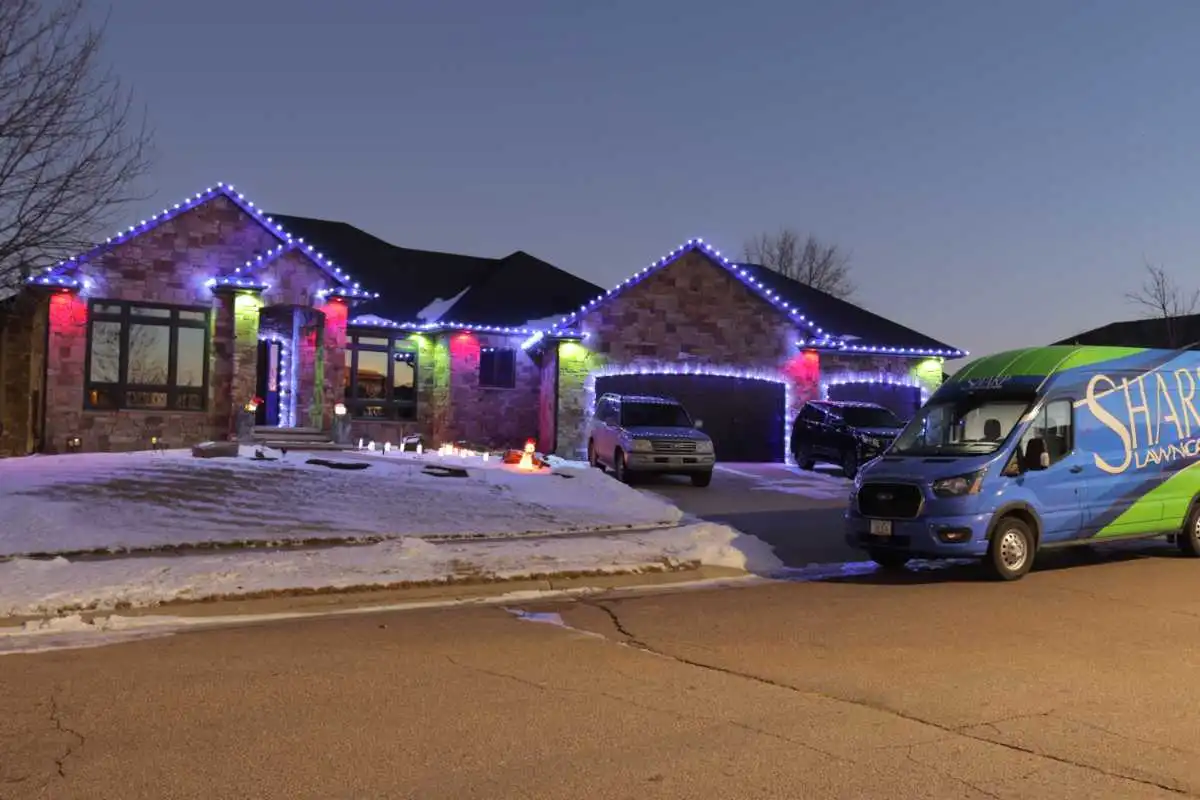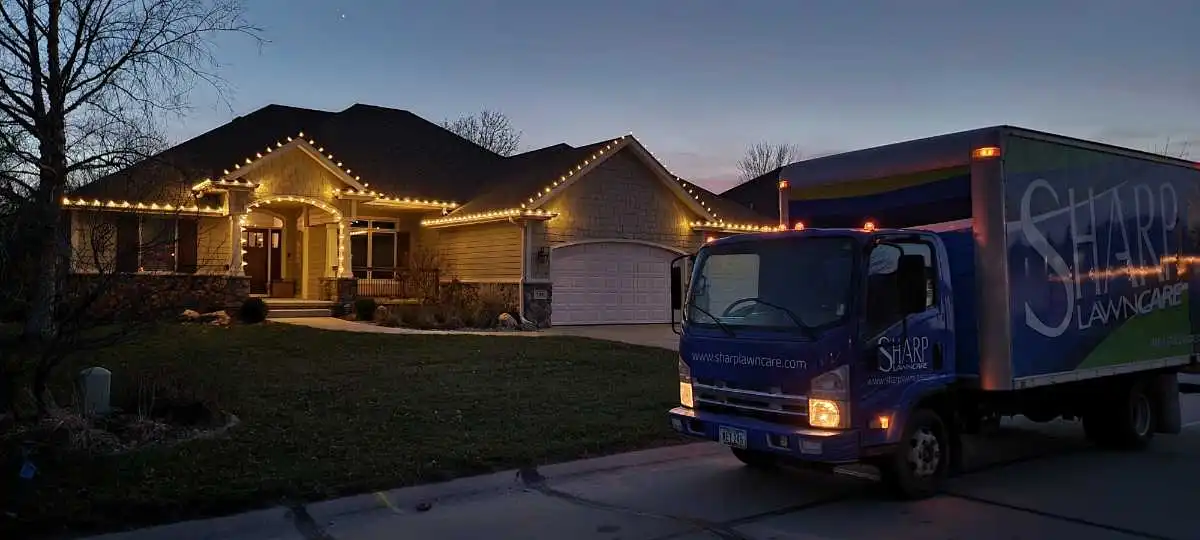Walk down any street in Sioux Falls, SD or Sioux City, IA in December and you’ll see the same big question glowing from every roofline and front porch: stick with traditional bulbs, or switch to LED Christmas lights? Homeowners want a display that looks good from the road, doesn’t wreck the budget, and doesn’t blow up the power bill.
This guide breaks down LED Christmas lights vs traditional Christmas lights in plain language. We’ll cover how each type affects energy use, how long they last, what works best for different home styles in the Midwest, and how to keep your family safe in real Siouxland winter weather. We’ll also touch on when DIY makes sense, when it’s smarter to call in a professional, and how your holiday display fits into your bigger plan for a healthy lawn.
1. LED vs traditional Christmas lights: what’s really different?

When people talk about “LED vs traditional Christmas lights,” they’re usually comparing modern LED strings to older-style incandescent bulbs. Both can look great. The difference is what’s happening behind the scenes with energy use, heat, and lifespan.
- Energy use: LED Christmas lights use far less electricity than incandescent strings. National energy agencies report that LEDs can use around 75–90% less energy than traditional bulbs, which adds up quickly when you’re lighting a complete roofline, trees, and shrubs for weeks at a time.
- Heat output: Incandescent bulbs get hot to the touch; most of the energy they consume is converted to heat, not light. LEDs stay much cooler, which is better for safety and for any greenery or decorations they come into contact with.
- Lifespan: A quality LED string is built to last for many seasons. LEDs are rated for tens of thousands of hours; many homeowners use the same sets for years before they even notice dimming. Incandescent bulbs burn out more often and are more likely to fail mid-season.
- Appearance: Older LEDs had a harsh, “blue-white” look. Today, you can get warm white LEDs that closely mimic the cozy glow of traditional bulbs, as well as cool white and multicolor options for a more modern look.
- Durability: LED Christmas lights typically have plastic lenses rather than glass bulbs, and the diodes are more shock-resistant. That’s helpful when you’re dealing with storage bins, kids, pets, and Midwest freeze–thaw cycles.
If you love the classic look of traditional Christmas lights but want a better handle on your power bill, modern LED Christmas lights give you most of that nostalgic feel with a fraction of the energy use and hassle.
2. How LED Christmas lights affect your power bill
Winter is already the most expensive time of year for electricity and gas in many Midwestern homes. When you add holiday lighting, you’re running extra wattage for 4–8 hours a night, often for a month or more. The type of bulb you choose makes a real difference in how much energy you use.
Here’s the bottom line from an energy standpoint:
- LED Christmas lights draw far fewer watts per strand. For the same number of bulbs, LEDs can use a small fraction of the power of incandescents while providing similar or even brighter light.
- More lights, same circuit. Because LEDs use less power, you can safely run more footage on an appropriately sized circuit without overloading outlets or tripping breakers—within manufacturer guidelines.
- Lower standby costs. If you forget to shut the lights off occasionally, the “penalty” with LEDs is less severe than with incandescents. It’s still good practice to use timers, but you have more margin for error.
To keep your power bill in check in Sioux Falls, SD and Sioux City, IA, combine LED Christmas lights with a few simple habits:
- Use timers or smart plugs. Set your display to run during your busiest evening hours (for example, 5–10 p.m.) instead of all night.
- Prioritize your focal points. If you’re watching the budget, focus LEDs on the roofline and on front-facing trees and shrubs most visible from the street, and keep side-yard lighting simple.
- Choose efficient layouts. A clean outline along the roof and a few accent trees often look better—and use less power—than random lights scattered everywhere.
You don’t need a complicated spreadsheet to see the difference. Swapping older, high-wattage strings for LED Christmas lights is one of the easiest ways to get a brighter display with less strain on your winter utility bill.
3. Picking the right LED Christmas lights for your home
Once you decide to go with LED Christmas lights, the next question is: which ones? There are more options than ever, and not all LED strings are created equal. Here are the main choices to think through before you start climbing ladders.
- Color temperature (warm vs cool white):
- Warm white (soft, slightly yellow) looks similar to traditional incandescent bulbs and feels cozy and classic.
- Cool white (crisp, slightly blue) gives a clean, “winter wonderland” look that pops against snow and ice.
- Multicolor is excellent for a playful or nostalgic feel, especially on trees and railings.
- Bulb size and style:
- C9 / C7 “roofline” bulbs: Larger bulbs are often used along gutters and peaks. Easy to see from the road and very popular for professional installs.
- Mini lights: Smaller bulbs that are ideal for wrapping trees, shrubs, railings, and columns.
- Icicle and net lights: Icicle strands along eaves and net lights over bushes can save installation time while still looking neat.
- Indoor vs outdoor rating: Always check the package or tag. Outdoor-rated LED Christmas lights are built to handle moisture, snow, and wind. Indoor-only sets shouldn’t be used on your roof in a Siouxland winter.
- Connectability: LED strings have limits on how many can be safely connected end-to-end. Quality strings clearly list those limits on the tag. Stick to those numbers so you don’t overload anything.
- Innovative features: Some LED Christmas lights can tie into smart home systems for dimming schedules, color changes, or syncing with music. Fun if you’re into tech, not required for a clean, professional look.
If you’re overwhelmed by the choices, start simple: warm white C9 LED bulbs along the roofline, then add mini LEDs to one or two accent trees. That combination works on most homes in Sioux Falls, SD and Sioux City, IA and gives you room to expand in future years.
4. Matching your lights to your home, style, and budget
The “best” Christmas lights aren’t the same for everyone. Your home’s architecture, the way your property sits on the street, and your personal style all matter. Here’s how we think about it when planning displays in the Sioux City and Sioux Falls metros.
For a classic, timeless look:
- Warm white C9 LEDs tracing the roofline and peaks.
- Matching warm white mini LEDs on one front tree or large shrub.
- Simple wreath or garland at the front door to tie everything together.
For a “show from the road” display:
- Roofline outlined with bright, warm, or cool white LEDs.
- Vertical features highlighted—columns, dormers, gables.
- Key trees wrapped up the trunk and partway into the main branches.
- Avoid lighting every single bush; focus on the elements that shape your home’s outline.
For townhomes and smaller lots:
- Clean roofline on the front only; no need to wrap the entire building.
- One focal element (a small tree, railing, or entry post) is lit with mini LEDs.
- Choose a color scheme that plays nicely with neighbors if you share a front elevation.
For acreage and corner lots:
- Prioritize what the main road sees: front roofline and the closest trees.
- Use LED floodlights or spotlights to highlight large trees or architectural stone, instead of trying to string lights 20 feet in the air.
- Remember access: in deeper snow or ice, you want a display that can still be serviced safely if something needs adjustment.
If your budget is tight, build a “base display” you can reuse year after year—usually the roofline—and add small pieces over time. LED Christmas lights make that strategy easier because the strings are designed for long-term use instead of a one-season throwaway.
5. Safety tips for LED and traditional Christmas lights
Energy savings are nice, but safety is non-negotiable—especially when we’re mixing electricity, ladders, and icy sidewalks. Whether you use LED Christmas lights, traditional bulbs, or a mix of both, a few rules apply in every yard in Sioux Falls, SD and Sioux City, IA.
- Inspect every string before use. Toss anything with cracked sockets, bare wire, or melted sections. Don’t “patch” damaged cords with tape and hope for the best.
- Use outdoor-rated cords and GFCI-protected outlets for outdoor use. For exterior displays, only use extension cords and light strings rated for outdoor use, plugged into properly grounded, protected outlets.
- Never overload circuits. Respect the “maximum strings” listed on the tag, especially for older incandescent sets, which draw much more power.
- Don’t staple through wires. Use plastic clips designed for holiday lights instead of nails, tacks, or metal staples that can pinch or pierce insulation.
- Watch ladders in winter. Avoid roof work in high wind, snow, or when there’s frost or ice on the shingles. Set ladders on solid, level ground and have a spotter when possible.
- Turn lights off when you’re asleep or away. Timers or smart plugs can shut the display down automatically overnight, reducing both energy use and risk.
For detailed safety checklists, homeowners can review resources from national energy agencies and university extensions, which regularly share seasonal guidance on electrical safety and holiday decorating best practices.
6. DIY vs professional LED Christmas light installation
Some homeowners enjoy spending a weekend on ladders, tweaking clips and patterns. Others look up at a steep roof in December and decide, “Nope.” Both approaches are common in Sioux Falls, SD and Sioux City, IA; the right choice depends on your home and your tolerance for risk, cold, and troubleshooting.
DIY can make sense if:
- You have a simple, single-story roofline with good access.
- You’re comfortable working on ladders and reading basic electrical load guidelines.
- You have time to install, check, take down, and store everything properly each year.
Professional LED Christmas light installation makes sense if:
- Your home has steep pitches, multiple stories, or tricky access points.
- You want a clean, custom look without having to guess at measurements or layout.
- You value having installation, maintenance, takedown, and storage handled for you.
- You want commercial-grade LED Christmas lights that are built for long-term use, not bargain-bin strings that fail mid-season.
At Sharp Lawn Care, our team designs and installs custom holiday lighting for homes, businesses, and HOAs. We measure your roofline, factor in wind exposure and outlet locations, select LED Christmas lights that match your style, and install them with safe, cold-weather techniques. If a bulb or section fails, we handle the fix. When the season ends, we return for takedown and storage so you’re not wrestling frozen clips in January.
Professional LED Christmas light installation in Sioux Falls, SD and Sioux City, IA gives you a brighter, safer display with less stress, while keeping energy use under control.
7. Planning around Siouxland weather
Holiday lighting in the upper Midwest is different than hanging lights in a mild climate. In the Sioux City and Sioux Falls areas, you’re dealing with early cold snaps, strong winds, and freeze–thaw cycles that can expose weak spots in any display.
To protect your lights—and your home—plan with local weather in mind:
- Schedule early. The best time for outdoor installs is typically before consistent freeze-up, when roof surfaces are dry and safer for ladder work.
- Expect wind. Choose LED Christmas lights and clips that sit tight against the roofline, and avoid big, floppy decorations that turn into sails on gusty days.
- Keep connections off the ground. Use drip loops, hang connections under eaves where possible, and avoid laying plugs in low spots where meltwater and refreeze happen.
- Think about snow piles. When you or your plow service stacks snow along the drive or walk, you don’t want to bury cords or crush low-to-the-ground decorations.
A little planning up front leads to a display that keeps working through real winter, not just the first calm week of December.
8. Your lawn under the lights: thinking beyond December
Christmas lights are short-term; your lawn is long-term. It’s worth considering how your display and foot traffic affect the grass beneath it, especially if you care about spring green-up.
- Protect high-traffic zones. Where ladders, cords, and repeated foot traffic cross the lawn, expect some compression and wear. Try to use the same paths each year so any damage is limited to small, recoverable areas.
- Avoid driving stakes through irrigation lines. If you have a sprinkler system, be careful where you anchor large lawn displays.
- Plan for spring recovery. After snow melts and the lights are packed away, compacted or worn areas can often bounce back faster with proper spring care.
Once the holidays are done, it’s a good time to think about your next steps for a healthy yard. Services like lawn aeration, overseeding, fertilization, and weed control help your turf recover from winter traffic and come back thicker and greener when the Christmas lights are only in storage.
Ready to choose the right Christmas lights for your home?
LED Christmas lights have come a long way. For most homes in Sioux Falls, SD and Sioux City, IA, they offer the best mix of beauty, durability, and energy savings. Traditional bulbs still have their fans, especially for that old-school glow, but they run hotter, use more power, and need more frequent replacement.
If you want a display that looks sharp, respects your budget, and doesn’t keep you on ladders in bad weather, you don’t have to figure it out alone. Our team at Sharp Lawn Care designs, installs, maintains, and removes professional holiday lighting so you can enjoy the season instead of wrestling tangled cords in the cold.
Have questions about LED vs traditional Christmas lights, or want help planning a display that fits your home and power bill? Reach out to us for a Christmas light consultation. We’ll talk through your goals, your home, and your budget, then build a plan that makes sense.
From the first bulb to the final takedown, Sharp Lawn Care helps homeowners in Sioux Falls, SD and Sioux City, IA get a bright, efficient, and worry-free holiday display.
We offer Christmas light services for residential and commercial properties, as well as HOAs, in Sioux Falls, SD, Sioux City, IA, and surrounding communities in South Dakota like Tea, Harrisburg, and Brandon. If your property is located in the Sioux City, IA area, contact us at (712) 253-8024. If your property is located in the Sioux Falls, SD area, contact us at (605) 251-6880 to schedule your holiday lighting.
And when the lights come down and it’s time to focus on the grass again, we’re here with year-round services—from fertilization and weed control to aeration and overseeding—to keep your lawn looking as good as your holiday display.
Energy and safety information in this article is supported by resources from national energy agencies and safety organizations, including guidance on LED efficiency, holiday lighting, and electrical safety best practices.
- U.S. Department of Energy – general guidance on LED energy efficiency and lifespan compared to incandescent bulbs.
- U.S. Department of Energy – educational overview of how holiday lights and circuits work.
- Iowa State University Extension AnswerLine – practical reminders on safe use and inspection of power and extension cords.
- Regional electric co-op and safety organizations – seasonal tips noting that LED holiday lights use roughly 75% less electricity than traditional incandescent lights and run cooler for improved safety.




Comments (0)
Thanks for your comment!
Thanks for your feedback! Your comments have been successfully submitted! Please note, all comments require admin approval prior to display.
Error submitting comment!
There is a problem with your comment, please see below and try again.